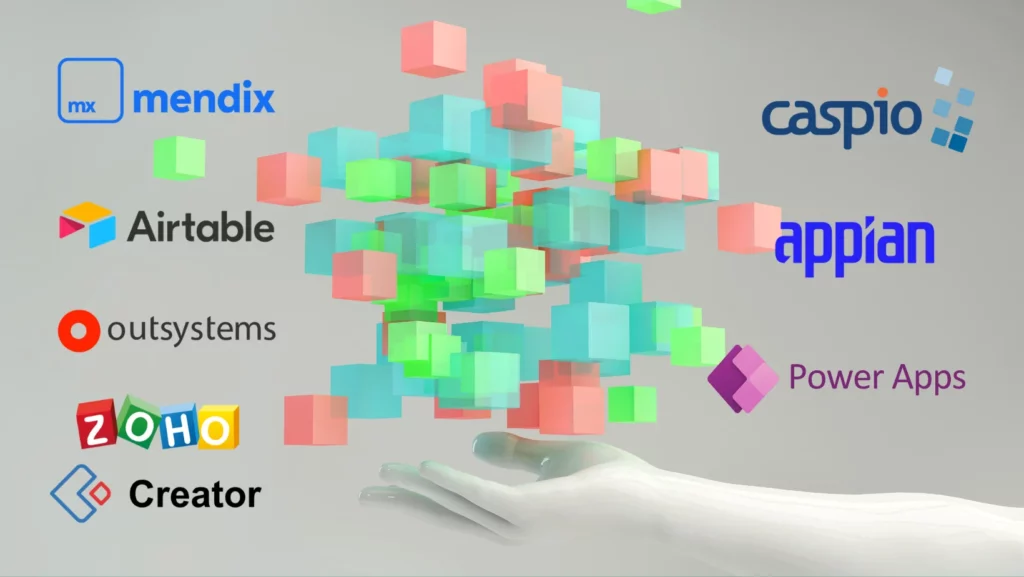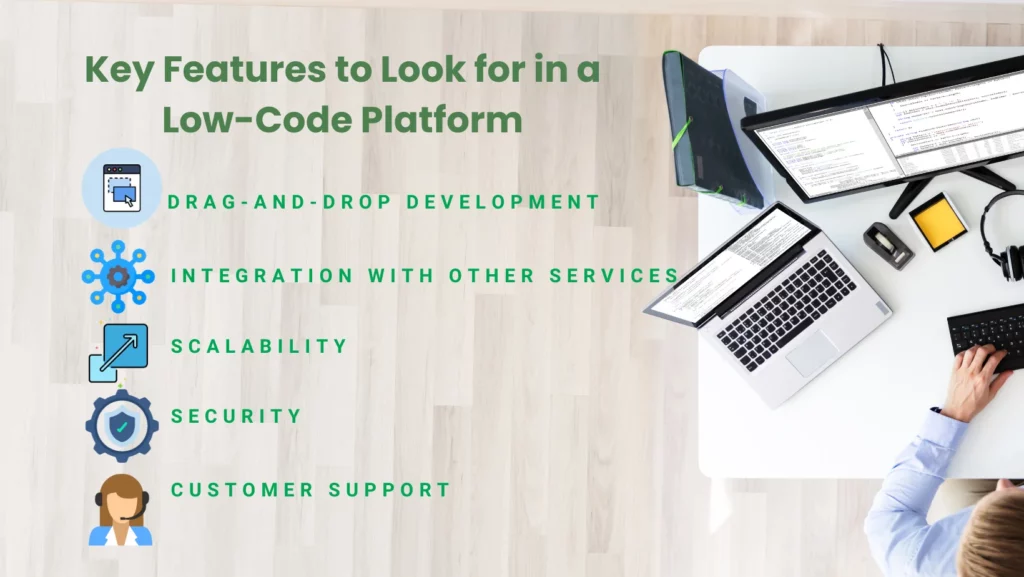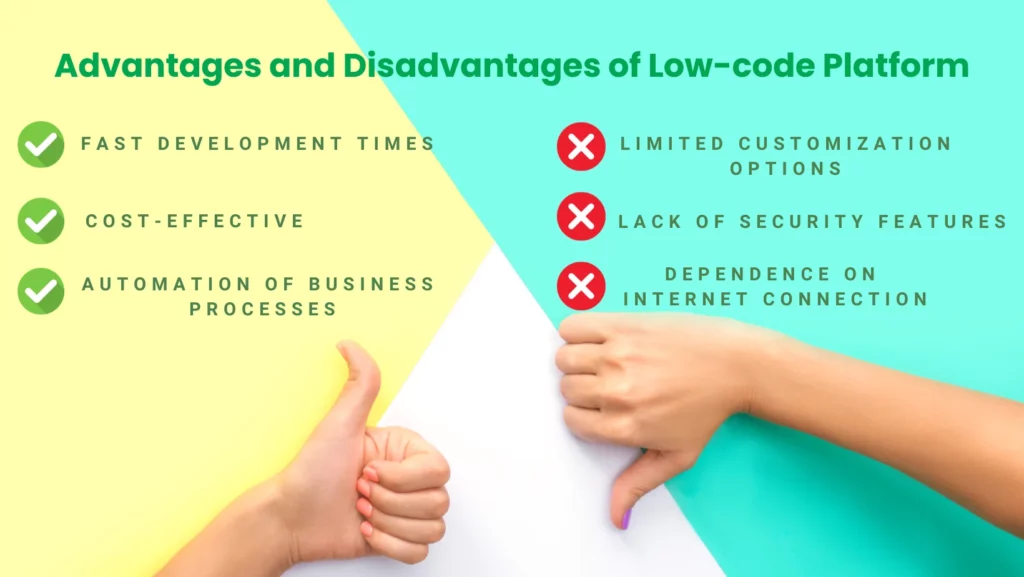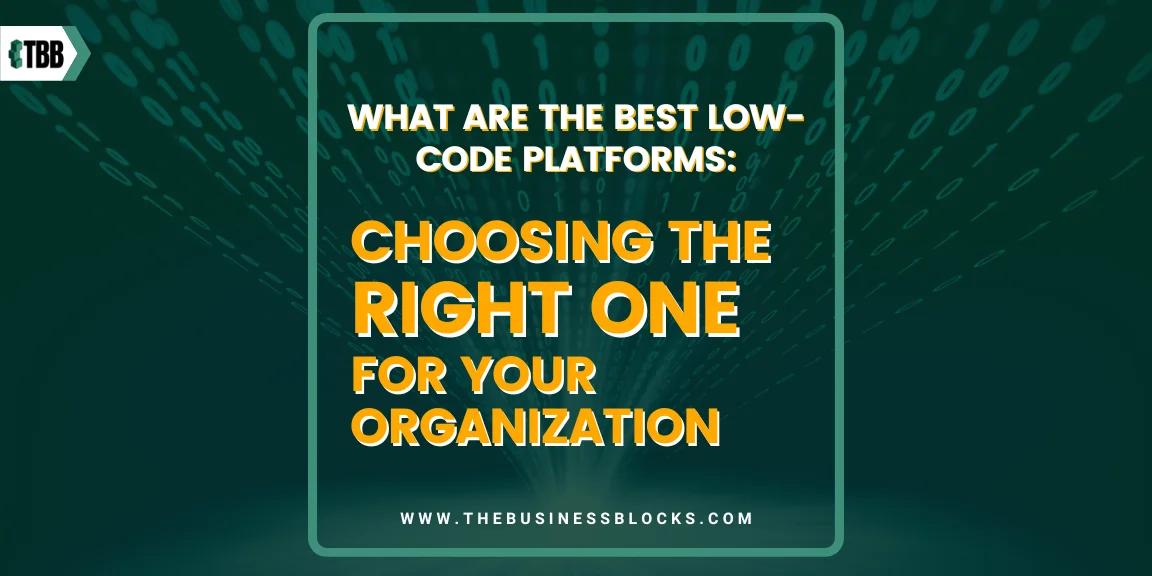Are you looking for a way to make your organization more agile and efficient with cutting-edge technology? Low-code platforms are becoming increasingly popular as they can help create enterprise applications quickly and easily. But, with so many different options available it can be difficult to choose the right one for your business needs.
In this article, we’ll explore what low-code platforms are, their benefits, and features, and guide you in making the best decision on which one is best suited for your organization’s specific needs. Read on to learn all about why the adoption of low-code solutions is important now more than ever.
Table of contents
- Having trouble deciding which Low-Code Platform Services to use?
- What is a Low-Code Platform and Why You Should Consider It?
- Understanding the Different Types of Low-code Platforms
- Evaluating Your Organization’s Needs When Choosing a Low-code Platform
- Analyzing the Top Low-code Platforms Available in the Market
- Exploring How to Choose The Right Low-Code Platform for Your Organization
- Key Features to Look for in a Low-Code Platform
- Advantages and Disadvantages of Low-code Platform
- Frequently Asked Questions About What Are The Best Low-code Platforms: Choosing the Right one for your Organization
Having trouble deciding which Low-Code Platform Services to use?
Low-code platforms enable organizations to quickly build applications and websites with minimal user coding. These services are designed to help you move faster and create more efficient processes, but choosing the right one can be overwhelming when there are so many different options on the market.
With The Best Low-Code Platforms from our team of experts, we can help make this process easier. Our guide will provide a comprehensive review of all the best low-code platforms available so that your organization can make an informed decision about which one is best for you.
Did you know?
- Low-code allows the average company to avoid hiring two IT developers, providing an additional $4.4 million in business value over three years plus labor reduction
- Gartner states that by 2023, there will be 4x more citizen developers than professional developers at large enterprises.
- 47% of developers said they don’t have access to the tools they need to build applications fast enough to meet deadlines
Read our guide now on how to find The Best Low-Code Platforms for Your Organization!
What is a Low-Code Platform and Why You Should Consider It?

A Low-Code Platform is a technology that allows developers and other non-technical personnel to create enterprise applications quickly with minimal code. This means you can build high-quality business applications, websites, and other digital products faster and more efficiently than ever before. It has a drag-and-drop interface and uses pre-built modules to give you more control and flexibility in the development process.
Low-code technology or low-code development platforms can help organizations save time, money, and resources while allowing them to focus more on innovation. It enables organizations to quickly build complex applications at a fraction of the cost it would take with traditional development methods. Additionally, Low-Code Platforms enable faster deployment cycles and allow you to quickly respond to customer needs and market trends.
Understanding the Different Types of Low-code Platforms
There are different types of Low-Code Platforms available, depending on different uses, and needs.
Here are the key types:
Enterprise Low-Code Platforms
These platforms are designed to help organizations build powerful enterprise applications quickly and easily. They offer a wide range of features such as drag-and-drop development, scalability, security, integration capabilities, and more.
Mobile Low-Code Platforms
These types of low-code platforms are designed for mobile app development. They are optimized for building apps with enhanced visual interfaces and offer various tools such as push notifications, analytics, data management, storage, and much more.
Web Low-Code Platforms
These platforms are designed to help develop web applications faster and easier. They provide an extensive range of features such as drag-and-drop development, integration with other web services and databases, as well as responsive design capabilities.
General Purpose Low-Code Platforms
This type of Low-Code platform is designed for users who do not have any coding experience. It provides an easy-to-use interface that allows users to create custom applications using a set of pre-built modules and components without having to write code.
Database Low-code Platforms
These types of Low-Code Platforms are designed for database and analytics applications. They provide features such as drag-and-drop development, data management, built-in analytics tools, and integration with other databases and services.
Low-code platforms are classified by different users and applications, and it is essential to assess the needs of each organization before purchasing any one. there are low-code platforms for business users and low-code platforms for developers.
Evaluating Your Organization’s Needs When Choosing a Low-code Platform

Considering Low-code development platforms or low-code tools can be a daunting task, and it is important to understand the needs of your organization before making any decision.
Before choosing a Low-Code Platform, you must first evaluate your specific needs for the following:
User experience
User experience in a Low-Code Platform means ease of use for both developers and non-technical users. It should be easy to understand, with an intuitive interface that makes it simple to create applications quickly and easily.
Security
Security is also a critical factor when choosing a Low-Code Platform. It should include features such as authentication, authorization, encryption, data protection, and secure access to your applications.
Scalability
It is important to choose a Low-Code Platform that can easily scale up or down depending on the needs of your organization. It should have the ability to accommodate more users, as well as handle larger workloads without any issues.
Features
The Low-Code Platform you choose should offer a wide range of features that make it easy to create and deploy applications quickly. This includes drag-and-drop development, integration capabilities, analytics tools, and much more.
Cost
The cost of the Low-Code Platform should be taken into consideration when making any decision. It is important to compare different pricing models before investing in a Low-Code Platform solution.
Customization
Customization is also an important factor to consider when selecting a Low-Code Platform. The platform should allow for customizations such as adding new features, changing the UI/UX, or integrating with other tools and services.
Support
It is important to choose a Low-Code Platform that provides excellent customer support. This will ensure that any issues or questions can be addressed quickly and effectively.
By considering the above factors, you will be able to make an informed decision when choosing a low-cost platform for your organization. Remember, low-code development tools are not all created equal, so be sure to do your research and choose the platform that best meets the needs of your organization.
Analyzing the Top Low-code Platforms Available in the Market

From business processes to mobile app development, the Low-Code Platforms market is expected to grow significantly over the next few years.
Here are some of the top Low-code platforms available in the market today:
Mendix
Mendix is an enterprise-grade low-code platform designed to help organizations quickly build complex applications. It offers a drag-and-drop visual modeler, cloud hosting, pre-built components, and more. It is an ideal platform for businesses of any size.
OutSystems
OutSystems is a low-code development platform that provides users with an easy-to-use drag-and-drop interface for creating applications quickly and easily. It offers features such as integration, scalability, security, mobile app development, and more.
Appian
Appian is a low-code platform designed to help organizations quickly build custom applications. It offers features such as drag-and-drop development, cloud hosting, integration with other services and databases, and more.
Airtable
Airtable is a low-code platform designed to help businesses build complex apps without writing code. It offers features such as drag-and-drop development, integration with other services and databases, support for custom fields, and more.
Caspio
Caspio is a low-code development platform designed for businesses of any size. It offers features such as drag-and-drop development, data security, integration with other services and databases, scalability, and more.
Zoho Creator
Zoho Creator is a cloud-based low-code platform designed to help organizations build custom applications quickly and easily. It offers features such as drag-and-drop development, mobile app development, integration with other services and databases, scalability, and more.
Microsoft Power Apps
Microsoft Power Apps is another popular low-code development platform that provides users with an easy-to-use drag-and-drop interface. It offers features such as cloud hosting, integration with other services and databases, scalability, security, and more.
These are just a few of the top Low-Code Platforms available in the market today. Each platform offers its own set of features and benefits, like automate processes, workflow automation, digital transformation, and other business processes, so it is important to evaluate your specific needs before making any decision. Additionally, you should research each platform thoroughly to ensure that it is the right fit for your organization.
Exploring How to Choose The Right Low-Code Platform for Your Organization
From mobile apps to workflow automation, Low-Code Platforms can be used to streamline business processes and help organizations quickly build custom applications. However, choosing the right platform for your organization can be a daunting task.
Here are some tips on how to choose the right low-code platform for your organization:
Evaluate Your Needs
Before you begin researching different platforms, it is important to evaluate your organization’s specific needs. This will help you determine which features are most important for the success of your project.
Research Different Platforms
Once you have identified your needs, it is time to begin researching different Low-Code Platforms. Read reviews and user testimonials to get a better understanding of each platform and its capabilities.
Compare Price and Features
It is also important to compare the price and features of each platform before making any decisions. Consider factors such as cost, ease of use, scalability, security, customization options, customer support, and more.
Test Out the Platform
Finally, it is recommended to try out a demo or free trial version of different Low-Code Platforms before making any decisions. This will ensure that the platform meets all of your organization’s specific needs and requirements.
Key Features to Look for in a Low-Code Platform

Professional developers and even citizen developers alike can take advantage of Low-Code Platforms to quickly and easily create apps. It is important to consider a few key features when choosing the right platform for your organization.
Here are some key features to look for in a Low-Code Platform:
Drag-and-Drop Development
The ability to quickly and easily create applications using a drag-and-drop interface is an important feature to look for in a Low-Code Platform. This will allow citizen developers to rapidly build business applications without having to write any code.
Integration with Other Services
The ability to integrate with other services and databases is also an important feature of a low-code platform. This will allow the platform to easily connect with existing data and other applications.
Scalability
The ability to scale up or down as needed is also important when choosing a Low-Code Platform. This will ensure that the platform can meet the changing needs of your organization.
Security
Security should be a priority when choosing any software, including a Low-Code Platform. Make sure to choose a platform that offers enterprise-grade security features such as encryption, authentication, and access control.
Customer Support
Finally, it is important to choose a low-cost platform that provides comprehensive customer support. This will ensure that any issues or questions you have can be quickly addressed by an experienced support team.
Advantages and Disadvantages of Low-code Platform

Depending on your organization’s need, a Low-Code Platform can be an ideal solution for quickly building applications. However, there are both advantages and disadvantages of using such a platform.
Here are some of the advantages and disadvantages of a Low-Code Platform:
Advantages
Fast Development Times
The drag-and-drop interface of Low-Code Platforms allows users to create complex applications quickly and easily. This eliminates the need to write code, resulting in shorter development times.
Cost-Effective
Low-code platforms are also usually more cost-effective than traditional software development. This makes them an ideal solution for organizations with limited budgets.
Automation of Business Processes
Low-Code Platforms can help automate business processes and workflows, resulting in improved efficiency and productivity.
Disadvantages
Limited Customization Options
Low-Code Platforms are limited in terms of customization options, which can be a problem for more complex applications.
Lack of Security Features
The security features offered by Low-Code Platforms may also not be as robust as those offered by traditional software development platforms. It is important to thoroughly research each platform before making any decisions.
Dependence on Internet Connection
Low-code platforms are dependent on an internet connection, so they may not be suitable for applications that require offline access.
Frequently Asked Questions About What Are The Best Low-code Platforms: Choosing the Right one for your Organization
Q: What is the difference between no-code platforms and low-code platforms?
A: No-code platforms allow users to create applications without writing any code, while Low-Code Platforms require some coding knowledge. No-Code Platforms are generally more user-friendly and easier to use, but may not offer as many features as a Low-Code Platform.
Q: What is the best Low-Code Platform for my organization?
A: The best Low-Code Platform for your organization will depend on the specific needs and requirements of your project. It is important to evaluate your needs, research different platforms, compare features and prices, and test out a demo or trial version before making any decisions.
Q: Are there any free Low-Code Platforms available?
A: Yes, there are several free Low-Code Platforms available. However, it is important to consider the features and limitations of each platform before deciding which one is right for you.
Conclusion
Ultimately, when it comes to selecting the best low-code platform for your organization, it is all about knowing what features you will need and making sure that the selected platform can meet those requirements. It is important to evaluate different technologies based on cost, scalability, complexity, security, and more.
Fortunately, there are now a variety of options out there that make selecting the right low-code platform easier than ever. Organizations that choose a low-code platform carefully tailored to their needs will likely see a major ROI over time – both in terms of financial savings as well as efficiencies and productivity gains. Take advantage of all the new opportunities available and start investing in technology today!

